The Best Saucony Running Shoes For Every Type Of Runner
Whether you’re looking for your first running shoe or a racer to help you set PBs, Saucony has an option for you
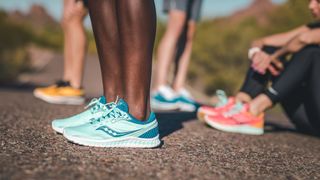
Even if you’ve never worn Saucony shoes before, it’s a brand you should be considering if you’re in the market for a new pair of running kicks. That’s because the American company has been firing out some of the best running shoes going in the past couple of years.
Saucony has a couple of the best carbon plate running shoes on the market in the Endorphin Pro 4 and Endorphin Elite, and my favorite all-round running shoe of the last few years is the Endorphin Speed 4. However, the brand excels in more than just speedy shoes: It also has a variety of cushioned running shoes for daily training, plus several top-notch trail shoes.
I’ve been running in and reviewing Saucony shoes for several years and have picked the best options for different types of runner below. It should be noted that none of the options below are especially cheap but many of them are the latest in a long-running line, so you will be able to find past editions of the shoe—or even the latest one—in sales, often with sizable discounts. Check our best budget running shoes page to keep up with prime deals.
How I Test Saucony Running Shoes
You can trust Coach
I usually run 50-70 miles a week in training on a mix of roads and trails, and race regularly to test shoes. I have a marathon PB of 2hr 28min and I’m always working hard to try and bring that time down with a structured training plan full of different types of runs, which makes it easy to rigorously test Saucony’s shoes for the purposes they’re designed for.
The Best Saucony Running Shoes

Specifications
Reasons to buy
Reasons to avoid
The Endorphin Speed 4 is the most versatile shoe available from any brand, with its main competition really being the Endorphin Speed 3, which is almost as good and now likely to appear in sales for less than the new shoe. The Speed 4 uses Saucony’s Peba-based PWRRUN PB midsole foam with a nylon plate that’s more stable and less stiff than the carbon plate used in the brand’s racers—creating a comfortable but still speedy ride for any kind of run.
I’ve used the various generations of the Speed in my own running shoe rotation for years and there’s not a type of run that I don’t enjoy using it for: from short speed sessions and races to recovery plods. It’s a great daily trainer that you can also use on race day, and for one-shoe runners it’s the clear pick from Saucony’s range.
Read more in our Saucony Endorphin Speed 4 review

Specifications
Reasons to buy
Reasons to avoid
The Saucony Endorphin Pro 4 is overshadowed by the top-of-the-range Endorphin Elite racing shoe. However, I think the Pro 4 is the better pick for most runners because it’s a fast carbon super-shoe in its own right, while also being cheaper and having a more natural and comfortable ride than the Elite.
I used the Pro 4 for some of my toughest marathon training workouts and it delivered the efficient and fast ride expected from a super-shoe. Compared to the Pro 3, Saucony has changed the midsole with the Pro 4 to have a top layer of the PWRRUN HG foam used on the Endorphin Elite, with a bottom layer of PWRRUN PB. For me, this results in a more propulsive ride than that of the Pro 3. The older Pro 3 is still a great carbon racer though, and one to look for in sales if you want a cheaper super-shoe.
Read more in our Saucony Endorphin Pro 4 review
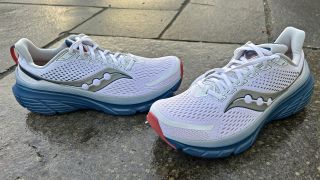
Specifications
Reasons to buy
Reasons to avoid
The Saucony Guide 17 is a cushioned daily trainer that uses features like a wide base and sidewalls of foam to create stability, rather than the more intrusive approach of a medial post that blocks overpronation. As a result, it’s a comfortable and supportive shoe for runners of all types and its mild rocker creates a smooth ride that works particularly well for ticking off easy miles. I rate the Tempus as the livelier, more versatile shoe, with the Guide 17 feeling a bit heavy if you try and use it for faster runs, though it can handle some speedwork if you just want one cushioned stability shoe for all your runs. Or, you can pair it with the Tempus for a two-shoe rotation that will cover your bases well.
Read more in our Saucony Guide 17 review
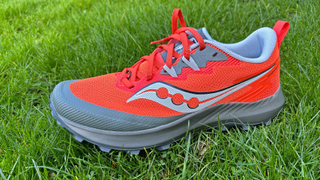
Specifications
Reasons to buy
Reasons to avoid
The Peregrine has long-been a go-to option for trail runners who need a reliable shoe for almost any kind of trail, with its versatile outsole gripping well on roads and hard tracks as well as deep mud. It’s not as cushioned as the Xodus Ultra 2, but the Peregrine 14 is comfortable enough for long runs, especially on soft ground, and it has a nimble feel that means you can use it for trail races as well as training runs.
You can get a Gore-Tex version of the Peregrine 14 if you want a waterproof upper and it’s a shoe that offers value by virtue of the fact both the current and older versions of the Peregrine frequently appear in sales. Right now, I rate the Peregrine 13 as the better-value option because Saucony has only made small changes to the upper of the Peregrine 14. So, if you spy the older shoe in sales it’s worth going for.
Read more in our Saucony Peregrin 14 review
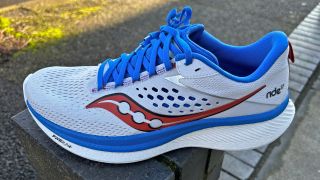
Specifications
Reasons to buy
Reasons to avoid
The updates Saucony has made to the Ride 17 make it similar to the Triumph 21—both shoes now have a PWRRUN+ midsole. The Ride 17 is heavier than the Triumph 21, but it’s cheaper and a great option for beginners thanks to the comfortable, protective ride.
I didn’t find the Ride 17 particularly versatile, and would mainly use it just for easy runs, but it does have a little bounce and would work as an all-rounder for newer runners who don’t have a running shoe rotation.
Read more in my Saucony Ride 17 review
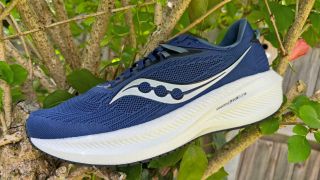
Specifications
Reasons to buy
Reasons to avoid
I’ve a lot of affection for Saucony’s Triumph line—an earlier model was the shoe I used most when first starting out in the sport. The latest version is one of the best cushioned shoes available from any brand and while the Ride 17 is similar, I still slightly prefer the Triumph 21 as the lighter and more versatile of the two, though it is more expensive.
The Triumph 21 affords the legs good protection thanks to the large stack of cushioning in the midsole, and will work well for runners tackling their first long-distance events. Given how similar the Ride 17 is to the Triumph 21, I expect a major update with the Triumph 22, but for now the 21 is my favorite cushioned Saucony shoe.
Read more in my Saucony Triumph 21 review

Specifications
Reasons to buy
Reasons to avoid
There are many caveats to note with the Endorphin Elite. The two biggest are that it provides a pretty harsh ride and is expensive. However, for pure speed it’s the best racer Saucony has made. I found it a truly exhilarating shoe for races and fast training sessions. The Elite has a bouncier, firmer ride than the Endorphin Pro 4 and has a more aggressive rocker that propels you onto your toes. It’s fast and efficient, but beats up your feet more than the comparatively relaxing ride of the Pro 4. The Pro 4 is probably the better buy for most runners, especially for long distances, but if it works for you the Elite is the speediest shoe in Saucony’s line-up.
Read more in my Saucony Endorphin Elite review

Specifications
Reasons to buy
Reasons to avoid
Like the excellent Endorphin road shoes, the Endorphin Edge has a PWRRUN PB midsole, Saucony’s Speedroll rocker geometry and a carbon plate. To adapt the shoe to the trails, Saucony has used a Carbitex carbon fiber plate, which is more flexible than plates used in road shoes and so better suited to running on uneven ground. The Edge also has a more aggressive outsole to provide grip on varied terrain, and the upper is more protective than the thin mesh materials used on the Speed 3 and Pro 3.
I only really felt the benefits of the plate and rocker in the Edge on relatively tame, hard and even trails, but it does provide a boost on those and it grips well and feels nimble enough on more technical tracks. It’s one of the best trail-running shoes available, and the best carbon shoe we’ve come across for off-road races, though the Hoka Tecton X2 is a close second and better on certain terrain.
Read more in my Saucony Endorphin Edge review

Saucony Tempus
Our expert review:
Specifications
Reasons to buy
Reasons to avoid
The Tempus is another shoe that not only tops its category within Saucony’s range, but is also the stand-out pick on the market at large. It’s a stable shoe that any runner will enjoy using, thanks to the midsole set-up that creates a bouncy, comfortable and stable ride that works well for a variety of training runs.
Instead of using traditional stability elements like a medial post, the Tempus has a firmer frame of PWRRUN foam around a bouncy PWRRUN PB core, a combo that creates its versatile and enjoyable ride. My main criticism of the shoe is that it’s quite pricy, and the Guide line from Saucony offers a cheaper option for stability-seeking runners.
The Tempus is my top pick in our round-up of the best stability running shoes, where you can also find out more info on this type of shoe in general.
Read more in my Saucony Tempus review
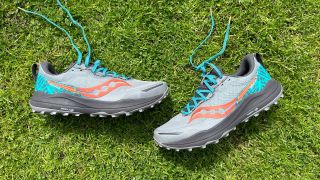
Saucony Xodus Ultra 2
Our expert review:
Specifications
Reasons to buy
Reasons to avoid
Once again Saucony has knocked it out of the park. The Xodus Ultra 2 is a versatile trail shoe that has become my favorite off-road option from any brand. It has Ultra in the name, and it’s designed to be comfortable over very long distances, but I enjoyed using it for pretty much any kind of run. Short, long, fast or slow, the Xodus Ultra 2 is terrific.
It has a similar midsole set-up to the Tempus road shoe, with a frame of firmer PWRRUN foam for stability, and a core of PWRRUN PB to deliver some bounce and help make the shoe pretty light considering the 4.5mm lugs on the outsole. Those lugs grip well on any surface except deep mud, where the Saucony Peregrine 13 would be a better option.
Read more in my Saucony Xodus Ultra 2 review

Specifications
Reasons to buy
Reasons to avoid
The Kinvara Pro has little in common with the classic Kinvara, which is a lightweight, low-drop shoe that eschews all the bells and whistles of modern trainers. The Pro version embraces those bells and whistles, with a ¾-length carbon plate and a high midsole stack that contains two different foams, with Saucony’s bouncy PWRRUN PB material as the top layer.
I didn’t love the Kinvara Pro. I found it heavy, and less enjoyable than the Endorphin Speed 3 for any kind of run. However, if you feel the Endorphin Speed or Pro shoes are too unstable and/or uncomfortable for you, the Kinvara Pro may be a more accessible carbon-plated alternative for a variety of runs.
Read more in my Saucony Kinvara Pro review
Get the Coach Newsletter
Sign up for workout ideas, training advice, reviews of the latest gear and more.

Nick Harris-Fry is a journalist who has been covering health and fitness since 2015. Nick is an avid runner, covering 70-110km a week, which gives him ample opportunity to test a wide range of running shoes and running gear. He is also the chief tester for fitness trackers and running watches, treadmills and exercise bikes, and workout headphones.
